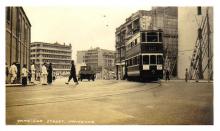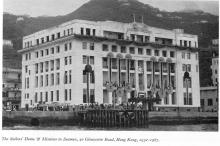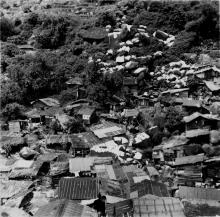Sailors Home and Mission to Seamen / Harcourt House [1933-c.1983]
Primary tabs
Submitted by David on Wed, 2013-10-02 17:32
Current condition:
Demolished / No longer exists
Date Place completed:
1933-04-23
Date Place demolished:
c.1983-12-31 (Year, Month, Day are approximate)
Tags:





Comments
Sailors' Home
Still writing the Mission history, but hoping to finish in a few weeks.
I have a small puzzle. The 40, Gloucester Rd building, completed in 1933, was an Art Deco building designed by Palmer & Turner, possibly by 'Tug' Wilson who also designed the contemporary HSBC building at 1 Queen's Rd., Central.
I had supposed that when the Missions to Seamen vacated for the Mariners' Club in 1967, the building was demolished. It wasn't. Government took it over, refurbished it and in 1968 it became the HQ of the HK Police Criminal Investigation Branch. That seemed to last until c.1971 when, again, govt. took the building in hand for renovation, this time initially to create staff residential accommodation, though by 1972 this had changed to conversion to a hostel for trainee nurses (148 female, 29 male) of Queen Mary Hospital (served by a shuttle bus). The first batch of trainees moved in in 1973 and the whole building was on stream in 1974. In 1972/73 it had been renamed Harcourt House. The hostel seems to have been in use until at least 1981. In July 1983 Hongkong Land bought the site, had done all the site preparation and foundation work by 1986 and in 1987 completed the present Harcourt House.
In short, with the demolition of the Sailors' Home and Missions to Seamen and the 1935 HSBC in a matter of perhaps 2-3 years 1981-1983, two classic Art Deco buildings of the 1930s, both by the same architecture firm and possibly by the same architect, were destroyed. Urban vandalism of no mean order.
What I'm, looking for, if anyone has it(them), is a c.1980 photo (or any other photos 1968-1981) of Harcourt House.
The site between the Sailors' Home and Mission to Seamen and the China Fleet Club remained a sand dump (sand bought by lighter to the se wall and then cross-loaded to the dump) until 1941. During the occupation the Japanese built a single or double storey bathhouse, the ruins of which stood until, after two abortive attempts to build an HQ for the HKRNVR and the newly founded Civil Aid Service, plus space for other government emergency outfits in 1951/52, the Royal Navy bought the site in 1953 and built the Coronation Annexe of the China Fleet Club, which opened in April 1954. So when Harcourt House (1st edition) was in operation, the whole block westwards on Gloucester Rd was occupied by the China Fleet Club and its annex.
StephenD
re: Sailors Home
Very interesting history - distant view but you can see it here http://gwulo.com/atom/20907, or in larger form here: https://www.flickr.com/photos/50256734@N05/16061875029/in/set-72157649808970337 and https://www.flickr.com/photos/50256734@N05/16222103786/in/set-72157649808970337
not the Sailors' Home (already posted on Wanchai waterfront)
This is indeed an example of the image I was hoping for. Thanks 80sKid for pointing it out. This is evidently what had become Harcourt House, at this stage still a nurses' hostel, and within a year or two of demolition. The date of the image is interesting because it is definite. Yet the image shows that the old Chine Fleet Club had already disappeared. The decision to redevelop had been take in 1979 and the official CFC history (http://www.china-fleet.co.uk/About-us/history) implies that demolition must have begin in 1980, so clearly from this photograph getting rid of the old building was a quick business. The new building was not ready for occupation until 1985, by which time the ex-Sailors' Home and Missions to Seamen, ex-Nurses' Hostel Harcourt House had already been demolished and the new building begun.
StephenD
Thanks for all the extra
Thanks for all the extra information.
I've added in the opening date from http://www.marinersclub.org.hk/our-history.html, and an estimated demolition date from Stephen's notes.
Regards, David
Re: Mission to Seamen
China Mail 7 February 1947
Severely damaged during the Occupation, renovations to the East Wing of the Mission to Seamen is now completed and open for meals and use as a dormitory. After the surrender, the building was requisitioned by the Navy and was known as "H.M.S. Orangi". The Navy vacated the premises in October 1946.
Sailor's Home
The full story of the site, from the reclamation to its cession by the then Sailors' Home & Missions to Seaman on the construction of the soon to be demolished Mariners' Club can be found in my Strong to Save: Maritime Mission in Hong Kong, from Whampoa Reach to the Mariners' Club, HK: City University of HK Press, 2017, Chs 10 & 11 and, for its post-war years, Chs 15-18.
After the Aorangi (sic) episode (see below) and its work 1946-1967 as the Sailors' Home and Missions to Seamen, the building was vacated but not, as had been intended, demolished. Instead government took it over, as it had the old Wanchai Mission in 1933 (which lasted until the 1960s!), with an intended new use first as a HK Police Criminal Investigation Branch, Commercial Crimes Office, Narcotics Bureau and Anti-Corruption Bureau HQ, which didn't happen, then as civil servant accommodation, which didn't happen, and then, after almost 5 years of it standing vacant (the HK Government's sub-competence is in its DNA) it was renamed Harcourt House and, as of April 1973, became a student nurses' hostel for trainees at Queen Mary (nice commute!) until its demolition in 1981. In 1983 the empty plot was bought by HK Land (who had sold it to the Mission in a nifty swap exercise in 1930) and the new Harcourt House was built (which unaccountably won an architectural award!).
The HMS was Aorangi, the Union Steamship Co's 17,491 GT liner, built on Clydeside in 1924, which had served on the New Zealand to Vancouver run until requisitioned for war service in summer 1941. She had served through the war as a troopship (and that's an interesting story too) before arriving in HK in September 1945 and being used until April or May 1946 as an accommodation ship, moored on buoys off Central (buoys A2 and A4 on her arrival, later on M1 (I think RN Buoy No. 1 SSW of Holt's Wharf)) of which the Wanchai premises were an extension. Following the Aorangi's return to civilian control in late March 1946, she left in early April 1946 carrying ex-prisoners of war back to Australia. After further civilian service the Aorangi was eventually sold for scrap in 1953. Meanwhile the Mission premises continued as HMS Aorangi until November 1946, when the entire premises were finally returned to civilian control and the Sailors' Home and Missions to Seamen.
Best,
Stephend
Thanks
Should have caught the mis-spelling of Aorangi in the first instance. Thanks and nice follow-up.
Aorangi
The Aorangi's stay in HK, which in early 1946 had looked like it was to be extended until October, occasioned a parliamentary question in UK about the misuse of very scarce merchant seamen and tonnage, tying them up (literally as it were) to servicing a static accommodation ship. The reply said the ship was essential to accommodate all the sailors (and soldiers - though was probably an error) who were being demobbed and held in HK until onward transport could be sorted out. And that it was "impossible" for RN personnel to operate a merchant vessel taken up into service.
No doubt in true bureaucratic fashion, there would have been declared absolutely no connection between the question in Parliament on 18th Feb 1946 and Aorangi being put into dock for titivation on 23rd March before being returned to civilian service (as far as I can work out, immediately she undocked on 28th March). But it's because that's what happened that the Wanchai Sailors' Home and Missions to Seamen became the only Mission to Seamen's premises in the world that served as an RN stone frigate. She was HMS Aorangi, as noted, from April 1946 until, having now double-checked, the end of September (so the Feb SCMP story of an October handover is probably correct although the actual handback date is uncertain). The new chaplain, Frank Weaver (who'd been the Missions to Seamen's man in Shanghai pre-war) arrived in early November (c. 10th) on the Denbighshire, though it wasn't until Feb (as in the story Moddsey quoted) that the Mission re-opened any accommodation.
During her time as a stone frigate the chapel was used as a dormitory for ratings (i.e. enlisted men). There was a 'ship's' wardroom on the first floor. The chaplain, a Hon Member of the wardroom, had to put up with an office in what had been the room in which apprentices dossed down. The whole shebang was run by a Commander RN who was a wondrous Catch-22 military bureaucrat. All merchant seafarers who wished to see the Mission chaplain to discuss their woes had to have a pass. But in order to get the pass they had to disclose the reason for their visit - almost always a confidential matter. So business was slack!
The first civilian re-use of part of the mission premises (in the basement) had been in July 1946, when the temporary chaplain, an Australian called Cecil Faulkner, held a party to celebrate. Faulkner was in HK from c.15 March 1946 through until he left after handing over on 13 Jan 1947. The last couple of months must have been a frosty time because Frank Weaver's first letter to head office in London referred to his predecessor as being 'slightly mental'!
The Aorangi eventually got back into civilian service in September 1948. She'd spent the period from her arrival in Sydney on 13 April 1946 with repatriated POWs and her return to service being reconverted from a troopship...or more like not being reconverted. The work, which had started in August 1946, had been supposed to take a few months. Union trouble one way or another stretched out the refit for two years until August 1948. Reading the newspaper stories of the recurrent strikes that delayed and delayed the work is amazing. There's an excellent resume of the ship's life at http://www.royalnavyresearcharchive.org.uk/BPF-EIF/Ships/AORANGI.htm#.XhQLyUczbb0 and a great photographic record and history at https://ssmaritime.com/Aorangi-II.htm, though the latter confuses the Aorangi with the Orantje anent a POW repatriation voyage in Sept 1945.
Best,
Stephend